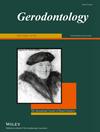Acceptability of teledentistry use among residents and staff in aged residential care facilities in the Otago region of New Zealand
Abstract
Objectives
To assess ARC residents' and staff perceptions of the benefits of, and comfort with, teledentistry use in ARC facilities in the Otago region of NZ, and identify end-user-level factors associated with its use.
Background
Difficulty in accessing oral healthcare services is a key barrier to aged residential care (ARC) residents' oral health and well-being. Teledentistry offers a possible solution, yet studies on its acceptability in ARCs are sparse, especially in New Zealand (NZ). This study assessed ARC residents' and staff perceptions of the benefits of, and comfort with, teledentistry use in ARC facilities in the Otago region of NZ and identified end-user-level factors associated with its use.
Materials and methods
Rest home-level residents and care staff in ARC facilities in the Otago region of NZ were surveyed to assess their awareness of teledentistry, perceptions of benefit and comfort using teledentistry, and end-user-level factors associated with the feasibility of using it in ARCs.
Results
One hundred residents and 77 care staff from 14 facilities participated. Three-quarters of resident participants thought that teledentistry was beneficial. Three in five resident participants were comfortable receiving remote dental consultations and care advice through teledentistry. Acceptability, as measured by perceived benefits and comfort, was lower among older participants. Staff participants were receptive to teledentistry use for residents and were comfortable facilitating remote dental consultations and care through teledentistry. No staff participants disagreed with the potential benefits of teledentistry for ARC residents.
Conclusion
Teledentistry would likely be acceptable to residents and staff in ARC facilities in NZ, contributing to residents' improved access to oral health care and improved oral health and well-being.

 求助内容:
求助内容: 应助结果提醒方式:
应助结果提醒方式:


